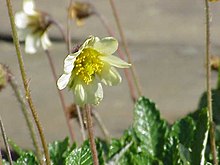Dryadoideae
Appearance
| Dryadoideae | |
|---|---|

| |
| Dryas × suendermannii | |
| Scientific classification | |
| Kingdom: | |
| (unranked): | |
| (unranked): | |
| (unranked): | |
| Order: | |
| Family: | |
| Genera | |
|
Cercocarpus Kunth | |
The Dryadoideae tribe of the Rosaceae consists of four genera,[1] all of which share root nodules that host the nitrogen-fixing bacterium Frankia.[2] They are sub-shrubs, shrubs, or small trees with a base chromosome number of 9, whose fruits are either an achene or an aggregate of achenes.[1]
Notes
- ^ a b Potter, D., et al. (2007). Phylogeny and classification of Rosaceae. Plant Systematics and Evolution. 266(1–2): 5–43.
- ^ Swensen, S.M.; Mullin, B.C. (1997). The impact of molecular systematics on hypotheses for the evolution of root nodule symbioses and implications for expanding symbioses to new host plant genera. Plant and Soil. 194: 185–192.
